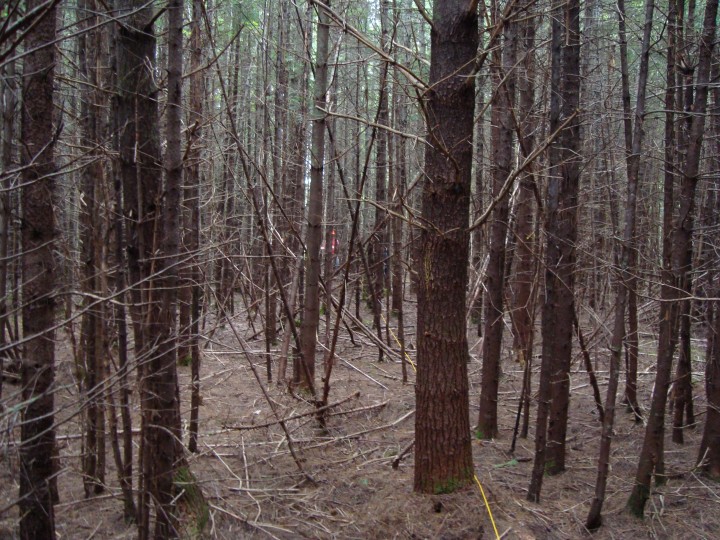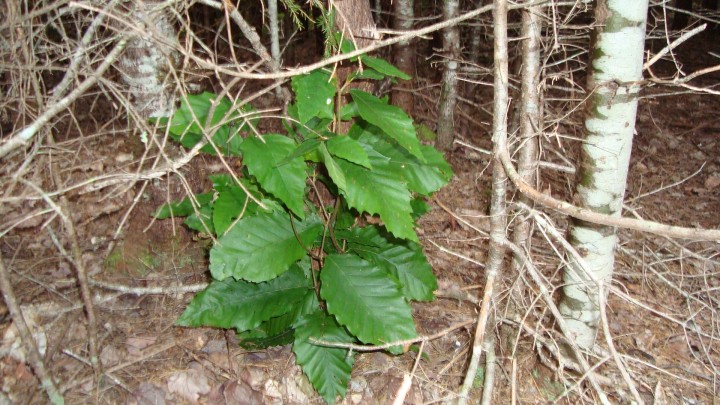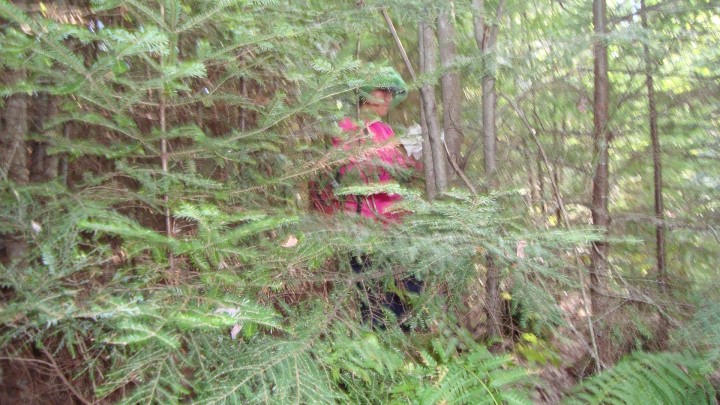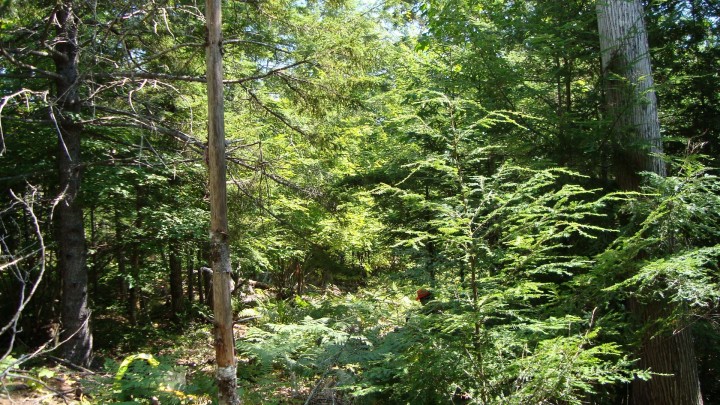North Woods, Maine 2009: August 21, 2009
August 21st, 2009 by Joanne HowlTemperature: 81 ° F Humidity: 100% Wind: 4 mph Foggy/Cloudy/light misting rain
Dr. Jon Ranson:
It’s amazing how different each day is, here in the North Woods. Early this morning there was this little mist falling. Everything was kind of soft and mysterious. Then the rain stopped and it turned awfully humid with no wind at all. I was recording measurements and standing still, but I was covered with sweat. I looked down and saw my shirt was soaked. Then I noticed the most curious thing. Near my feet were a few big rocks. And they looked like they were sweating, too.
Of course, rocks can’t sweat, not like you and I do. I knew that it was just condensation. The rocks had cooled off in the night and they were warming slower than the air. The air was so moist that the dew point was really close to the temperature. Because the air around the rocks was slightly cooler it couldn’t hold as much moisture, so dew formed. As a scientist, I know all this. But as a guy standing in the forest, hot and dripping, I liked imagining that both the rocks and I were covered in sweat. I liked feeling that bit of kinship with the earth. Sometimes it’s better to set logic aside and just live the experience.

The Penobscot Experimental Forest. This site is very densely populated with white pine and balsam fir. The forest is dark, with any green out of sight high overhead and a thick litter of dry pine needles on the floor.
Today we started a new plot in a section of forest which is, once again, completely different than anywhere else we’ve been. The trees are mostly balsam fir and white pine, plus a few deciduous trees here and there. The floor is deeply covered in dry pine needles. All the green needles are high up in the top of the canopy. Everything at eye level is brown and dry. It’s dark in this forest. Some clouds passed overhead around five in the afternoon and I actually wanted a flashlight to help me read the data sheet.
The trees are all about the same age and size here, all about 13-15 cm DBH. It’s really dense, too. We measured 140 trees in one 25 meter by 25 meter plot. They are fairly small in diameter but they are tall, so that’s a lot of biomass. Since the live branches are only at the top of the trees, the lower branches are all dead and broken off. There are bits of branches sticking out everywhere, right at eye level. Now I understand the safety lecture better: we’ve found the eye-poke forest.
We also found two American Chestnut trees. They are quite small but it’s always thrilling to find a rare species. At one time the chestnut covered about one third of the forest in the Appalachians. They were so common, goes the story, that a squirrel could start in Maine and travel through chestnut branches all the way to Georgia without once having to put a paw on the ground. About 1904 a fungus was introduced and the adult trees began to die. Within a half-century adult trees were almost a thing of the past.
There are still some American Chestnuts living today. Most of them, like the ones we found, sprout from the roots of dead trees. The blight will kill almost all of them long before they get big enough to produce nuts. I understand that near here, in the Piscataquis Preserve, there is what is believed to be the largest stand of reproducing American Chestnuts left in existence. One tree measures 34 inches in diameter, truly an amazing thing. These two we found would be mere twigs compared to that tree, but we’re still happy to see them.

- A small American Chestnut sprouting from a dead stump. At one time the American Chestnut comprised about 1/3 of the Appalachian forests. Today the species is rare. This tree will likely die of blight before it is old enough to produce nuts.
One of our scientists, Kathleen Bergen, said she saw a huge spider running around in the woods today. She described it as something that looked kind of like Darth Vader – really big and dark. Everyone thought that was really cool and wished they could have seen it and maybe speciated it, too.
When we were driving home they had their chance. First, let me say, I had 8 people crammed in my car. We are a car short – the tires on the one are still a problem so it can’t be driven. We are making do the best we can, but it’s a bit chaotic. Today, I’m up front listening to the chatter from the back and then suddenly there’s this huge commotion. Folks were scrambling and jumping. Someone, Jeremy I think, was yelling “Catch it! Save the spider!” Kathleen was assuring everyone that it looked just like the Darth Vader spider she’d seen in the woods.
Now, I’m okay with spiders, but I’m not big on them sharing my personal space. I kept the car on the road as six scientists pursued the spider in the back seats. I remember turning to Ross Nelson, in the passenger seat, who was sitting calmly and smiling. I muttering something, I think about how much I hoped they caught the thing, because I knew no one wanted to experience this driver with a Darth Vader spider crawling up his back.
By the time we made it back to the hotel, the spider had saved itself by escaping the clutches of the scientifically curious as well as avoiding the driver’s deadly lead foot. Unfortunately that means it has hidden itself somewhere in my car’s interior. I hope it’s wise enough to find its way out tonight. As I said, I’m really not big on sharing my personal space with spiders.
You know, it seems like there has been a lot of laughter on this trip. We’re working really hard, but we are having a good time. In Siberia we were always joking in the woods and laughing off the hardships, but I see it happening here, too, where things are not so hard. I think it’s the forests. I believe there’s something about being out in the forest that is just really, really good for the soul.




